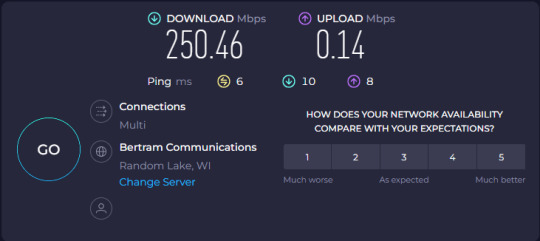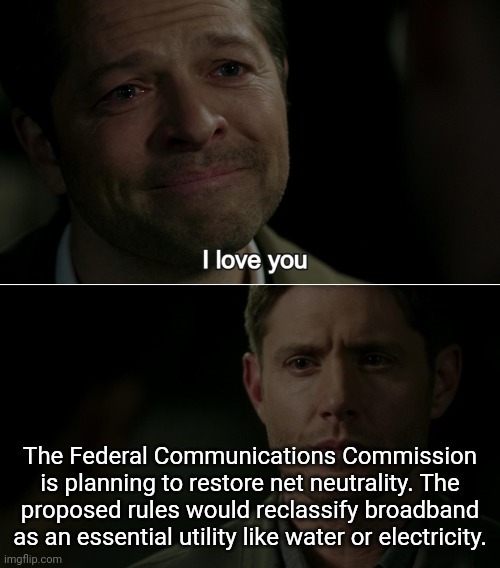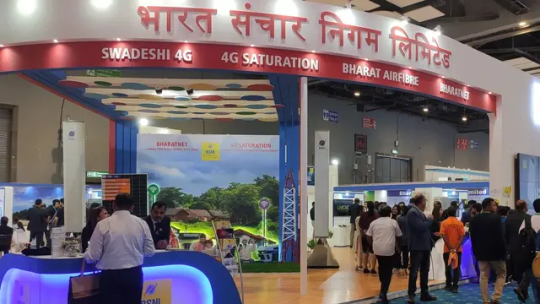#rural broadband
Explore tagged Tumblr posts
Text
George Chidi at The Guardian:
Elon Musk, named by Donald Trump to co-lead a commission aimed at reducing the size of the federal government, is poised to undermine funding for rural broadband services to benefit his satellite internet services company, Starlink. Musk has long been a critic of the Biden administration’s Broadband Equity, Access, and Deployment (Bead) Program, which provides $42.45bn through the Bipartisan Infrastructure Bill to expand high-speed internet access in rural communities. Starlink, the satellite internet services subsidiary of SpaceX, has largely been shut out of this funding after government agencies deemed it too slow to qualify. But with Trump’s election, and the deference Trump appears poised to give to Musk’s desired reforms, the world’s richest man could re-prioritize how the federal government provides high-speed internet to rural America, creating an immense conflict of interest. If Musk recommends cuts to government spending on rural fiber optic broadband – as he has repeatedly suggested – it directly increases the value of Starlink’s satellite internet services.
“We have never had a situation where the leading shareholder of a communications company has both a position – both in terms of influencing the president, but also having an assignment to drive efficiency in government – with so many government contracts,” said Blair Levin, a telecommunications industry analyst with New Street Research and the Brookings Institution. “That is an extraordinary situation. That is unprecedented.” Levin suggested that Trump could order Bead funding to be withheld indefinitely as soon as he takes office, even though Congress has authorized the funding. Doing so would violate the 1974 Impoundment Control Act, a law Trump fell afoul of in his first term that ultimately resulted in one impeachment. But Musk and Vivek Ramaswamy, who will co-lead the commission to reduce the size of the federal government, argued in a Wall Street Journal editorial last week that Trump should pursue impoundment when he deems it necessary.
“Mr Trump has previously suggested this statute is unconstitutional, and we believe the current supreme court would likely side with him on this question,” they wrote. Any move like this would tie the program in legal knots as lawsuits abound, Levin said. But the delay is the point. “While states and others could file legal actions to stop such a pause, we think most courts would be reluctant to enjoin or otherwise stop the administration from reconsidering some elements of the program. Even actions of dubious legality can benefit Starlink through delay or through litigation.” Musk had set his sights on the Federal Communications Commission (FCC) and the National Telecommunications and Information Administration (NTIA) long before Trump’s victory. The NTIA administers federal grant funding for the Bead program. Without a government subsidy, rolling fiber optic lines down country roads to serve a handful of houses at a time is usually too cost-prohibitive for an internet service provider. But to companies like AT&T or Verizon, a government subsidy to a local internet service provider also looks like the government funding the competition.
Big telecom companies and the FCC argued long and loud about what parts of the country had access to high-speed service, and thus didn’t need government money. But the definition of “high speed” used by industry and the government was often slow by many standards. After years of negotiation, lawsuits and politicking, the FCC and the NTIA settled on a modern definition for broadband service: 100 megabits per second (Mbps) download speeds, 20Mbps upload speeds, with less than 100 milliseconds of latency. Right now, Starlink doesn’t meet that standard. It has been getting slightly slower over time even as more people sign up for service, according to internet performance testing service Ookla’s speed tests. In 2022, the FCC rescinded a $900m grant from the Rural Digital Opportunity Fund to Starlink to connect rural communities to the internet, citing its failure to meet the speed and latency standards and declining network performance.
Musk erupted on an X post. “Starlink is the only company actually solving rural broadband at scale! They should arguably dissolve the program and return funds to taxpayers, but definitely not send it those who aren’t getting the job done,” Musk wrote. ”What actually happened is that the companies that lobbied for this massive earmark (not us) thought they would win, but instead were outperformed by Starlink, so now they’re changing the rules to prevent SpaceX from competing.” In June, Musk described the Bead program, which began rolling out grants to states this year, as “an outrageous waste of taxpayer money and is utterly failing to serve people in need”. A month later, Musk endorsed Trump and began a $100m spending campaign in support of his candidacy.
After Musk started to gain Trump’s ear – and particularly after Musk’s endorsement and Starlink’s deployment of satellite terminals to areas hit by Hurricane Helene, which Trump praised regularly on the campaign trail – Trump’s language about rural broadband began to shift in Musk’s direction. Trump described Starlink as “better than the wires”, when talking with Joe Rogan in the much-watched podcast interview. “We’re spending a trillion dollars to get cables all over the country, right, up to upstate areas where you have like two farms … They haven’t hooked up one person.” Over the last year, the FCC commissioner – and Trump’s newly named FCC chair – Brendan Carr has also echoed Musk’s position, arguing that the public might be better off by subsidizing the cost of Starlink terminals instead of fiber optic broadband. After Trump’s election, Carr said the FCC is unlikely to revisit its rescission of Starlink’s grant, citing procedural hurdles. But Carr, who authored the FCC chapter of Project 2025, has suggested that as much as a third of Bead funding could go to satellite internet providers.
The “Department of Government Efficiency (DOGE)” co-headed by Elon Musk and Vivek Ramaswamy is just another self-enrichment scam.
6 notes
·
View notes
Text
#satellite internet#space#starlink#elon musk#spacex#internet#isp#hughesnet#technology#rural broadband
0 notes
Text
Leveraging Facebook Groups: A Guide to Marketing and Adding Subscribers for Your WISP or ISP

Wireless Internet Service Providers (WISPs) and Internet Service Providers (ISPs) face unique challenges when it comes to marketing and expanding their subscriber base. One powerful tool that often goes underutilized in this industry is Facebook Groups. With its massive user base and diverse communities, Facebook Groups provide an excellent platform for WISPs and ISPs to connect with potential customers, build brand awareness, and ultimately add subscribers. In this guide, we’ll explore the strategies and best practices for using Facebook Groups effectively.
Understanding the Power of Facebook Groups
1. Identifying and Joining Relevant Groups:
Begin by searching for and joining groups that align with your WISP or ISP’s target audience. Look for local community groups, technology enthusiasts, and groups related to internet services.
2. Establishing Your Presence:
Once you’ve joined relevant groups, introduce your company and its services. Share your company’s mission, values, and unique selling points. Be transparent about the benefits of choosing your WISP or ISP.
3. Providing Value Through Content:
Share informative and engaging content related to your industry. This could include articles, infographics, or videos about the latest advancements in internet technology, tips for improving connectivity, or updates on your services.
Building Relationships and Engaging with the Community
1. Actively Participating in Discussions:
Engage in conversations within the groups. Respond to comments on your posts and participate in discussions related to internet services. This helps humanize your brand and establishes you as an industry expert.
2. Hosting Q&A Sessions and Webinars:
Leverage the group platform to host live Q&A sessions or webinars. This allows you to directly address potential customers’ questions, showcase your expertise, and promote your WISP or ISP services.
3. Offering Exclusive Group Deals and Promotions:
Encourage group members to become subscribers by offering exclusive deals or promotions. Highlight special offers available only to group members, creating a sense of exclusivity and urgency.
Leveraging Facebook Group Features
1. Utilizing Announcements and Events:
Make use of the group’s announcement feature to share important updates or promotions. Additionally, create and promote events such as service launches, community outreach initiatives, or informational sessions.
2. Running Contests and Giveaways:
Generate excitement and interest by organizing contests or giveaways within the group. This not only increases engagement but also helps spread the word about your WISP or ISP services.
3. Encouraging User-Generated Content:
Request and showcase user-generated content, such as testimonials, success stories, or photos of satisfied customers using your services. This builds trust and credibility among group members.
Monitoring Analytics and Adapting Strategies
1. Tracking Engagement Metrics:
Regularly monitor the performance of your posts using Facebook Insights. Pay attention to metrics such as reach, engagement, and click-through rates. Use this data to refine your content strategy.
2. Gathering Customer Feedback:
Actively seek feedback from group members about your services. Use this information to address concerns, improve your offerings, and demonstrate your commitment to customer satisfaction.
3. Iterating and Evolving:
Social media is dynamic, and so should be your approach. Continuously iterate your strategies based on the evolving needs and preferences of the group members. Stay adaptable and be open to experimenting with new ideas.
In conclusion, Facebook Groups offer a dynamic and interactive platform for WISPs and ISPs to market their services and add subscribers. By strategically leveraging the features and engaging with the community, these providers can build a robust online presence, establish credibility, and ultimately grow their subscriber base in an increasingly competitive market.
#WISPMarketing#ISPExpansion#FacebookGroupStrategies#communityengagement#SocialMediaForISPs#fixedwireless#rural broadband#broadband#ruralconnectivity#highspeedinternet
0 notes
Text
Speech Vice President Harris gave at the WV State Capitol!


#kamala harris#tim walz#harris walz 2024 campaigning#policy#2024 presidential election#legislation#united states#hq#politics#democracy#democratic party#west virginia#Glenn Elliott#rural america#broadband#infrastructure
3 notes
·
View notes
Text
AN OPEN LETTER to THE U.S. CONGRESS
Fund the Affordable Connectivity Program NOW!
130 so far! Help us get to 250 signers!
I’m a concerned constituent writing to urge you to fund the Affordable Connectivity Program or ACP. Digital connectivity is a basic necessity in our modern world and the internet must be treated as a public utility. We use the internet to apply for jobs, perform our jobs, receive telehealth medical treatment, and pay bills, and students use it to complete homework assignments. But for millions of people in rural and urban areas, and Tribal communities, the internet is a luxury they cannot afford. Failure by Congress to fund this program will force millions of households already on tight budgets to choose between being able to stay online or potentially losing access to this essential service. If Congress doesn’t act fast, funding for the Affordable Connectivity Program will run out and more than 22 million Americans -- 1 in 6 households -- will lose this vital service. The implications of this will be devastating. In 2019, 18% of Native people living on Tribal land had no internet access; 33% relied on cell phone service for the internet; and 39% had spotty or no connection to the internet at home on their smart phone. The ACP has enrolled 320,000 households on Tribal lands -- important progress. The largest percentage gains in broadband access are in rural areas. Nearly half of military families are enrolled in ACP, as are one in four African American and Latino households. Losing access and training on using computers and the internet will have devastating impacts on all these communities as technology becomes increasingly integral to work, education, health, and our everyday lives. Without moves to address tech inequality, low-income communities and communities of color are heading towards an “unemployment abyss.” The Affordable Connectivity Program has broad bipartisan support because it is working. As your constituent, I am urging you to push for renewed funding for the ACP before it runs out in the coming weeks.
▶ Created on April 11 by Jess Craven
📱 Text SIGN PJXULY to 50409
🤯 Liked it? Text FOLLOW JESSCRAVEN101 to 50409
#JESSCRAVEN101#PJXULY#resistbot#petition#Affordable Connectivity Program#Digital Divide#Internet Access#Broadband Access#ACP Funding#Congress Funding#Public Utility#Internet Equality#Telehealth#Telemedicine#Internet Inequality#Digital Inclusion#Internet For All#Rural Connectivity#Bipartisan Support#Internet Infrastructure#FCC#ACP Support#Digital Navigation#Online Education#Remote Work#Job Access#Telecommunications#Internet Service#Internet Affordability#Digital Equity
4 notes
·
View notes
Text

This connection is supposed to be symmetrical.
#ineffablefool original post#not good omens#it's been like this for over a day now and customer support has no ETAs no explanation#although if you keep escalating up their chain then you'll keep getting completely different mutually contradictory details!#pretty cool how they're one of exactly two options for broadband in this very much not rural area#and the other option is the one where we tried to switch to them once but their installer guy was 100% incompetent#and responded to our saying 'do not go in this one room' by going 'nah it's fine' and strolling on in there anyway#(he left the room eventually but it was definitely not until he was good and ready)#(imagine letting a service person into your house and then they decide to wander around in an off-limits room for a couple minutes#while you are standing there insisting firmly that they Do Not#it is *so awkward*#and what do you do like?? call the cops??? dude will just leave the room before they show up and then you look like a weirdo)#he also promised to not knock an access hole in a specific area of wall but then when he got outside he just went ahead and did it anyway#and just left it there for us to find when we went outside after he'd gone#i seldom hope people get fired but gosh i hope that at some point he got fired#ANYWAY i guess what i'm saying is that i would like a pretty angel to give me hot chocolate + listen to my woes + miracle them all better#but who doesn't amirite?
9 notes
·
View notes
Text
Like to charge, reblog to cast

source 1
source 2
#::gets the zoomies:: OMGOMGOMGOMGOMGOMG THIS IS FANTASTIC. I volunteer on the board#for a small municipal district that's bringing broadband internet to rural Vermont. This is such an important thing.#PLEASE PLEASE PLEASE let this happen!
99K notes
·
View notes
Text








#12dBi Outdoor Antenna#3G 4G LTE Network Antenna#4g antenna for home#4G Router External Antenna#best wifi network range extender#Broadband Signal Amplifier#High-Gain 360° Antenna#NETBOON External Antenna#Omni Antenna for Rural Areas#Omni-Directional LTE Antenna#Outdoor Wi-Fi Antenna#Signal Booster Antenna for Routers#wifi range extender antenna#Wireless Signal Enhancer
0 notes
Text
Top broadband official exits Commerce Department with sharp Musk warning - POLITICO
0 notes
Text
Driving Digital Inclusion Nationwide BSNL mobile recharge offers today
Bharat Sanchar Nigam Limited (BSNL) is a nation-owned telecommunications employer in India, supplying a wide range of telecom offerings across the united states. bsnl broadband plans for rural areas established on October 1, 2000, BSNL emerged from the Department of Telecommunications (DoT) and speedy have become certainly one of the most important and oldest conversation provider vendors in India. With its giant community infrastructure and various provider services, performs a important function in connecting human beings and groups national.

History and Evolution
Formation and Early Years
BSNL strains its roots returned to the British era while telecommunication offerings have been first delivered in India. bsnl ftth plans for high speed internet post-independence, the telecom zone became controlled through the Department of Telecommunications (DoT). In 2000, DoT became split into entities: BSNL for service provision and MTNL (Mahanagar Telephone Nigam Limited) for services in metropolitan regions. This restructuring aimed to promote opposition and improve provider performance.
Growth and Expansion
BSNL to start with centered on landline services and progressively expanded its portfolio to include mobile offerings, net broadband, business enterprise answers, and extra. Over the years, It has contributed considerably to the digital transformation of India, bridging the city-rural divide and bringing telecom offerings to far flung regions.
Services Offered by BSNL
Landline Services
It remains a main provider of landline cellphone offerings throughout India, imparting reliable connectivity and lower priced price lists.
Landline services are critical for families, corporations, and authorities places of work, imparting stable voice communique and net get entry to.
Mobile Services
It is operates a strong mobile community, catering to hundreds of thousands of subscribers national.
It offers prepaid and postpaid cellular plans, consisting of voice calls, SMS, records services, and cost-added services.
Our cellular network coverage extends to rural and remote regions, assisting virtual inclusion and connectivity.
Broadband and Internet Services
We are affords broadband net offerings over DSL, fiber optic, and wireless technologies.
Its broadband plans cater to residential and enterprise customers, providing high-pace internet connectivity for browsing, streaming, gaming, and on-line packages.
It has performed a key position in increasing broadband get entry to to underserved areas, contributing to India's virtual infrastructure improvement.
Its broadband plans cater to residential and business users, offering high-speed internet connectivity for browsing, streaming, gaming, and online applications.
Enterprise Solutions
It gives a number corporation answers along with MPLS (Multi-Protocol Label Switching), leased strains, VPN (Virtual Private Network), and controlled offerings.
These services aid agencies, authorities corporations, and establishments with secure and scalable connectivity solutions.
Value-Added Services
We are offers various fee-brought offerings along with caller tunes, overlooked call signals, mobile banking, and more.
These offerings enhance person revel in and cater to numerous consumer desires within the virtual age.
Network Infrastructure
Telecom Network
It operates a vast telecom network comprising landline exchanges, cell towers, fiber optic cables, and satellite conversation centers.
Its network infrastructure supports voice, information, and multimedia offerings, ensuring reliable connectivity across urban and rural regions.
Digital Initiatives
It has undertaken several digital initiatives to modernize its network infrastructure and improve service delivery.
Initiatives include the deployment of fiber-to-the-home (FTTH) services, upgrading mobile networks to support 4G and beyond, and enhancing network capacity and coverage.
Challenges and Competitive Landscape
Competition
It operates in a extraordinarily competitive telecom marketplace alongside personal operators like Reliance Jio, Bharti Airtel, and Vodafone Idea.
Competition has pushed innovation, progressed carrier excellent, and led to aggressive pricing inside the telecom sector.
Financial and Operational Challenges
It has confronted financial challenges, such as revenue declines and operational inefficiencies.
Government initiatives and restructuring efforts aim to revitalize BSNL's operations and beautify its competitiveness within the market.
Government Initiatives and Support
Digital India
It performs a crucial role inside the Government of India's Digital India initiative, which ambitions to transform India right into a digitally empowered society and expertise economic system.
The initiative promotes virtual literacy, broadband connectivity, e-governance, and virtual infrastructure development across the united states.
2. Universal Service Obligation Fund (USOF)
It gets aid from the Universal Service Obligation Fund (USOF), which subsidizes the value of imparting telecom offerings in rural and far flung regions.
USOF projects help BSNL increase its community coverage and bridge the virtual divide via imparting low-cost telecom services to underserved populations.
Future Prospects and Innovation
1. 5G Readiness
It is getting ready for the rollout of 5G technology in India, aiming to install 5G networks and offerings to decorate facts speeds, connectivity, and aid for rising technology.
5G adoption will enable to provide advanced mobile broadband, IoT (Internet of Things) connectivity, and modern digital offerings.
Digital Transformation
BSNL mobile recharge offers today it keeps to focus on virtual transformation initiatives, which include community modernization, automation, and enhancing patron enjoy.

Embracing digital technologies will strengthen BSNL's competitive role and permit it to meet evolving consumer needs inside the virtual generation.
0 notes
Text
Best Practices for Back Office Operations in WISPs and ISPs

Introduction
In the fast-paced world of Wireless Internet Service Providers (WISPs) and Internet Service Providers (ISPs), the efficiency of back office operations is paramount. The back office serves as the nerve center, handling critical functions such as billing, customer support, and network management. In this blog post, we’ll delve into the best practices that can transform back office operations, driving success and ensuring a seamless experience for both the provider and its customers.
Automation is the Key:
Embrace automation to streamline repetitive tasks and reduce manual errors. Automate billing processes, invoicing, and routine network checks to free up valuable human resources for more strategic endeavors. This not only improves efficiency but also enhances accuracy in critical operations.
Integrate Comprehensive Billing Systems:
Implementing a comprehensive billing system is crucial for WISPs and ISPs. Opt for billing systems that can handle complex pricing structures, manage diverse subscription plans, and facilitate easy customization. This ensures accurate billing, reducing disputes and improving cash flow.
Customer-Centric CRM Solutions:
A Customer Relationship Management (CRM) system tailored to the unique needs of WISPs and ISPs is indispensable. Look for solutions that provide a 360-degree view of customer interactions, enabling personalized services, efficient issue resolution, and proactive customer engagement.
Efficient Network Monitoring:
Invest in advanced network monitoring tools to ensure optimal performance and quick issue resolution. Real-time monitoring helps detect anomalies promptly, minimizing downtime and enhancing the overall quality of service. Regularly update and expand these tools to stay ahead of emerging challenges.
Employee Training and Cross-Functional Teams:
Equip your back office staff with the skills and knowledge necessary for their roles. Establish cross-functional teams to encourage collaboration and shared knowledge. This ensures that each team member has a broader understanding of the business, fostering adaptability and efficiency.
Data Security and Compliance:
Prioritize data security to safeguard sensitive customer information and comply with industry regulations. Regularly update security protocols, conduct thorough audits, and educate staff on cybersecurity best practices. Customer trust is built on the foundation of a secure and compliant back office.
Streamlined Inventory Management:
For WISPs and ISPs managing physical equipment, efficient inventory management is vital. Keep track of assets, minimize excess inventory, and implement a systematic approach to equipment replacement. This prevents unnecessary costs and ensures the availability of up-to-date hardware.
Responsive Technical Support Systems:
Implement a responsive and efficient technical support system with an emphasis on automation. Utilize automated ticketing systems to track and resolve customer issues promptly. Regularly analyze support data to identify patterns and proactively address potential network or service issues.
Continuous Process Improvement:
Foster a culture of continuous improvement by regularly evaluating and refining back office processes. Encourage feedback from employees and customers to identify areas for enhancement. This adaptability is essential for staying ahead in the dynamic landscape of WISPs and ISPs.
Conclusion
In the world of WISPs and ISPs, the efficiency of back office operations is a game-changer. By implementing these best practices, providers can enhance customer satisfaction, optimize resource allocation, and position themselves as leaders in the competitive telecommunications industry. A well-organized and responsive back office is not just a support system; it’s the driving force behind a successful and customer-centric WISP or ISP.
#BackOfficeEfficiency#AutomationInTelecom#ISPBestPractices#networkmanagement#telecominnovation#fixedwireless#rural broadband#connectivitysolutions#ruralconnectivity
0 notes
Text
May You Have Health & Wealth in 2024
Photo by Monstera Production on Pexels.com It looks to be a good year for our nation under the leadership of Joe Biden as the economy has taken off chugging like the steam locomotives my Grandpa used to work on for Southern Railway. The stock market finished the year at the highest mark ever. So much for all the gloom and prophesying of a “recession the likes of which we’ve never seen before”…

View On WordPress
0 notes
Text
Wireless Internet Providers
We currently have sites covering over 2,000 square kilometres of the King Country and we’re continually looking to expand. Find out today if we’re in your area.
https://wirelessdynamics.co.nz/go/
0 notes
Text
Utah’s getting some of America’s best broadband

TOMORROW (May 17), I'm at the INTERNET ARCHIVE in SAN FRANCISCO to keynote the 10th anniversary of the AUTHORS ALLIANCE.

Residents of 21 cities in Utah have access to some of the fastest, most competitively priced broadband in the country, at speeds up to 10gb/s and prices as low as $75/month. It's uncapped, and the connections are symmetrical: perfect for uploading and downloading. And it's all thanks to the government.
This broadband service is, of course, delivered via fiber optic cable. Of course it is. Fiber is vastly superior to all other forms of broadband delivery, including satellites, but also cable and DSL. Fiber caps out at 100tb/s, while cable caps out at 50gb/s – that is, fiber is 1,000 times faster:
https://www.eff.org/deeplinks/2019/10/why-fiber-vastly-superior-cable-and-5g
Despite the obvious superiority of fiber, America has been very slow to adopt it. Our monopolistic carriers act as though pulling fiber to our homes is an impossible challenge. All those wires that currently go to your house, from power-lines to copper phone-lines, are relics of a mysterious, fallen civilization and its long-lost arts. Apparently we could no more get a new wire to your house than we could build the pyramids using only hand-tools.
In a sense, the people who say we can't pull wires anymore are right: these are relics of a lost civilization. Specifically, electrification and later, universal telephone service was accomplished through massive federal grants under the New Deal – grants that were typically made to either local governments or non-profit co-operatives who got everyone in town connected to these essential modern utilities.
Today – thanks to decades of neoliberalism and its dogmatic insistence that governments can't do anything and shouldn't try, lest they break the fragile equilibrium of the market – we have lost much of the public capacity that our grandparents took for granted. But in the isolated pockets where this capacity lives on, amazing things happen.
Since 2015, residents of Jackson County, KY – one of the poorest counties in America – have enjoyed some of the country's fastest, cheapest, most reliable broadband. The desperately poor Appalachian county is home to a rural telephone co-op, which grew out of its rural electrification co-op, and it used a combination of federal grants and local capacity to bring fiber to every home in the county, traversing dangerous mountain passes with a mule named "Ole Bub" to reach the most remote homes. The result was an immediately economic uplift for the community, and in the longer term, the county had reliable and effective broadband during the covid lockdowns:
https://www.newyorker.com/tech/annals-of-technology/the-one-traffic-light-town-with-some-of-the-fastest-internet-in-the-us
Contrast this with places where the private sector has the only say over who gets broadband, at what speed, and at what price. America is full of broadband deserts – deserts that strand our poorest people. Even in the hearts of our largest densest cities, whole neighborhoods can't get any broadband. You won't be surprised to learn that these are the neighborhoods that were historically redlined, and that the people who live in them are Black and brown, and also live with some of the highest levels of pollution and its attendant sicknesses:
https://pluralistic.net/2021/06/10/flicc/#digital-divide
These places are not set up for success under the best of circumstances, and during the lockdowns, they suffered terribly. You think your kid found it hard to go to Zoom school? Imagine what life was like for kids who attended remote learning while sitting on the baking tarmac in a Taco Bell parking lot, using its free wifi:
https://www.wsws.org/en/articles/2020/09/02/elem-s02.html
ISPs loathe competition. They divide up the country into exclusive territories like the Pope dividing up the "new world" and do not trouble one another by trying to sell to customers outside of "their" turf. When Frontier – one of the worst of America's terrible ISPs – went bankrupt, we got to see their books, and we learned two important facts:
The company booked one million customers who had no alternative as an asset, because they would pay more for slower broadband, and Frontier could save a fortune by skipping maintenance, and charging these customers for broadband even through multi-day outages; and
Frontier knew that it could make a billion dollars in profit over a decade by investing in fiber build-out, but it chose not to, because stock analysts will downrank any carrier that made capital investments that took more than five years to mature. Because Frontier's execs were paid primarily in stock, they chose to strand their customers with aging copper connections and to leave a billion dollars sitting on the table, so that their personal net worth didn't suffer a temporary downturn:
https://www.eff.org/deeplinks/2020/04/frontiers-bankruptcy-reveals-cynical-choice-deny-profitable-fiber-millions
ISPs maintain the weirdest position: that a) only the private sector can deliver broadband effectively, but b) to do so, they'll need massive, unsupervised, no-strings-attached government handouts. For years, America went along with this improbable scheme, which is why Trump's FCC chairman Ajit Pai gave the carriers $45 billion in public funds to string slow, 19th-century-style copper lines across rural America:
https://pluralistic.net/2022/02/27/all-broadband-politics-are-local/
Now, this is obviously untrue, and people keep figuring out that publicly provisioned broadband is the only way for America to get the same standard of broadband connectivity that our cousins in other high-income nations enjoy. In order to thwart the public's will, the cable and telco lobbyists joined ALEC, the far-right, corporatist lobbying shop, and drafted "model legislation" banning cities and counties from providing broadband, even in places the carriers chose not to serve:
https://pluralistic.net/2023/03/19/culture-war-bullshit-stole-your-broadband/
Red states across America adopted these rules, and legislators sold this to their base by saying that this was just "keeping the government out of their internet" (even as every carrier relied on an exclusive, government-granted territorial charter, often with massive government subsidies).
ALEC didn't target red states exclusively because they had pliable, bribable conservative lawmakers. Red states trend rural, and rural places are the most likely sites for public fiber. Partly, that's because low-density areas are harder to make a business case for, but also because these are also the places that got electricity and telephone through New Deal co-ops, which are often still in place.
Just about the only places in America where people like their internet service are the 450+ small towns where the local government provides fiber. These places vote solidly Republican, and it was their beloved conservative lawmakers whom ALEC targeted to enact laws banning their equally beloved fiber – keep voting for Christmas, turkeys, and see where it gets you:
https://communitynets.org/content/community-network-map
But spare a little sympathy for the conservative movement here. The fact that reality has a pronounced leftist bias must be really frustrating for the ideological project of insisting that anything the market can't provide is literally impossible.
Which brings me back to Utah, a red state with a Republican governor and legislature, and a national leader in passing unconstitutional, unhinged, unworkable legislation as part of an elaborate culture war kabuki:
https://www.npr.org/2023/03/24/1165975112/utah-passes-an-age-verification-law-for-anyone-using-social-media
For more than two decades, a coalition of 21 cities in Utah have been building out municipal fiber. The consortium calls itself UTOPIA: "Utah Telecommunication Open Infrastructure Agency":
https://www.utopiafiber.com/faqs/
UTOPIA pursues a hybrid model: they run "open access" fiber and then let anyone offer service over it. This can deliver the best of both worlds: publicly provisioned, blazing-fast fiber to your home, but with service provided by your choice of competing carriers. That means that if Moms for Liberty captures you local government, you're not captive to their ideas about what sites your ISP should block.
As Karl Bode writes for Techdirt, Utahns in UTOPIA regions have their choice of 18 carriers, and competition has driven down prices and increased speeds. Want uncapped 1gb fiber? That's $75/month. Want 10gb fiber? That's $150:
https://www.techdirt.com/2024/05/15/utah-locals-are-getting-cheap-10-gbps-fiber-thanks-to-local-governments/
UTOPIA's path to glory wasn't an easy one. The dismal telco monopolists Qwest and Lumen sued to put them out of business, delaying the rollout by years:
https://www.deseret.com/2005/7/22/19903471/utopia-responds-to-qwest-lawsuit/
UTOPIA has been profitable and self-sustaining for over 15 years and shows no sign of slowing. But 17 states still ban any attempt at this.
Keeping up such an obviously bad policy requires a steady stream of distractions and lies. The "government broadband doesn't work" lie has worn thin, so we've gotten a string of new lies about wireless service, insisting that fiber is obviated by point-to-point microwave relays, or 5g, or satellite service.
There's plenty of places where these services make sense. You're not going to be able to use fiber in a moving car, so yeah, you're going to want 5g (and those 5g towers are going to need to be connected to each other with fiber). Microwave relay service can fill the gap until fiber can be brought in, and it's great for temporary sites (especially in places where it doesn't rain, because rain, clouds, leaves and other obstructions are deadly for microwave relays). Satellite can make sense for an RV or a boat or remote scientific station.
But wireless services are orders of magnitude slower than fiber. With satellite service, you share your bandwidth with an entire region or even a state. If there's only a couple of users in your satellite's footprint, you might get great service, but when your carrier adds a thousand more customers, your connection is sliced into a thousand pieces.
That's also true for everyone sharing your fiber trunk, but the difference is that your fiber trunk supports speeds that are tens of thousands of times faster than the maximum speeds we can put through freespace electromagnetic spectrum. If we need more fiber capacity, we can just fish a new strand of fiber through the conduit. And while you can increase the capacity of wireless by increasing your power and bandwidth, at a certain point you start pump so much EM into the air that birds start falling out of the sky.
Every wireless device in a region shares the same electromagnetic spectrum, and we are only issued one such spectrum per universe. Each strand of fiber, by contrast, has its own little pocket universe, containing a subset of that spectrum.
Despite all its disadvantages, satellite broadband has one distinct advantage, at least from an investor's perspective: it can be monopolized. Just as we only have one electromagnetic spectrum, we also only have one sky, and the satellite density needed to sustain a colorably fast broadband speed pushes the limit of that shared sky:
https://spacenews.com/starlink-vs-the-astronomers/
Private investors love monopoly telecoms providers, because, like pre-bankruptcy Frontier, they are too big to care. Back in 2021, Altice – the fourth-largest cable operator in America – announced that it was slashing its broadband speeds, to be "in line with other ISPs":
https://pluralistic.net/2021/06/27/immortan-altice/#broadband-is-a-human-right
In other words: "We've figured out that our competitors are so much worse than we are that we are deliberately degrading our service because we know you will still pay us the same for less."
This is why corporate shills and pro-monopolists prefer satellite to municipal fiber. Sure, it's orders of magnitude slower than fiber. Sure, it costs subscribers far more. Sure, it's less reliable. But boy oh boy is it profitable.
The thing is, reality has a pronounced leftist bias. No amount of market magic will conjure up new electromagnetic spectra that will allow satellite to attain parity with fiber. Physics hates Starlink.
Yeah, I'm talking about Starlink. Of course I am. Elon Musk basically claims that his business genius can triumph over physics itself.
That's not the only vast, impersonal, implacable force that Musk claims he can best with his incredible reality-distortion field. Musk also claims that he can somehow add so many cars to the road that he will end traffic – in other words, he will best geometry too:
https://pluralistic.net/2022/10/09/herbies-revenge/#100-billion-here-100-billion-there-pretty-soon-youre-talking-real-money
Geometry hates Tesla, and physics hates Starlink. Reality has a leftist bias. The future is fiber, and public transit. These are both vastly preferable, more efficient, safer, more reliable and more plausible than satellite and private vehicles. Their only disadvantage is that they fail to give an easily gulled, thin-skinned compulsive liar more power over billions of people. That's a disadvantage I can live with.

If you'd like an essay-formatted version of this post to read or share, here's a link to it on pluralistic.net, my surveillance-free, ad-free, tracker-free blog:
https://pluralistic.net/2024/05/16/symmetrical-10gb-for-119/#utopia

Image: 4028mdk09 (modified) https://commons.wikimedia.org/wiki/File:Rote_LED_Fiberglasleuchte.JPG
CC BY-SA 3.0 https://creativecommons.org/licenses/by-sa/3.0/deed.en
338 notes
·
View notes